Change Management in Healthcare: NHS Cerner Literature Review
VerifiedAdded on 2020/06/04
|9
|2458
|34
Report
AI Summary
This report provides a comprehensive literature review on change management within healthcare organizations, specifically focusing on the National Health Service (NHS) in the United Kingdom and the role of Cerner. It explores the impact of information technology and electronic medical records on healthcare professionals and institutions, highlighting the challenges and opportunities associated with these changes. The review discusses key concepts, critical success factors, and current challenges in change management, drawing on various theories and research, including Kotter's change management theory and Lewin's change model. The report emphasizes the importance of adapting to technological advancements, improving patient care, and enhancing the efficiency of healthcare services. It also addresses the complexities of managing change, including training costs and resistance to new technologies, while highlighting the benefits of strategic implementation and support for healthcare professionals. Ultimately, the report concludes that effective change management is crucial for the growth and development of healthcare organizations, with a focus on the role of technology and the need for strategic planning.

Managing change in
healthcare organisation NHS
Cerner
healthcare organisation NHS
Cerner
Paraphrase This Document
Need a fresh take? Get an instant paraphrase of this document with our AI Paraphraser
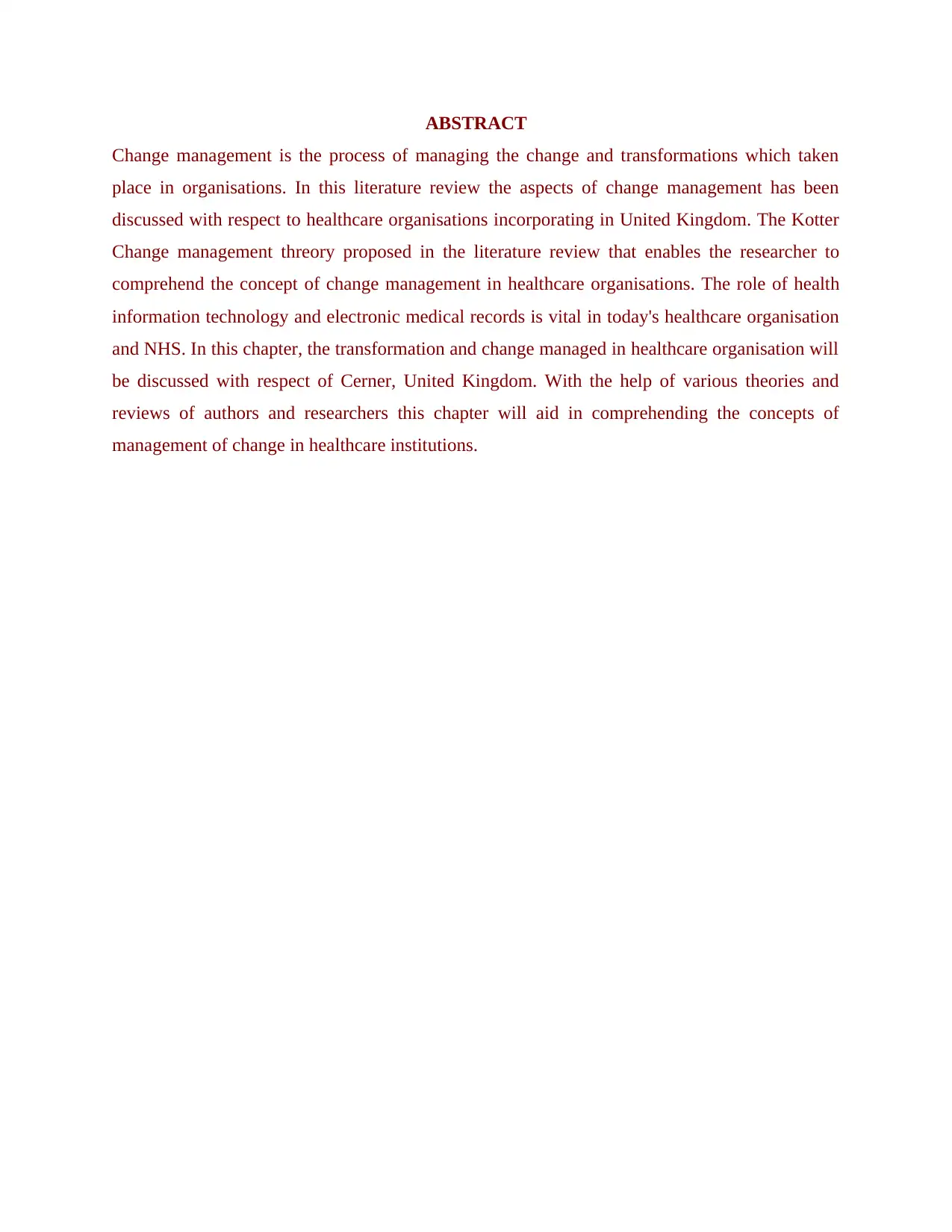
ABSTRACT
Change management is the process of managing the change and transformations which taken
place in organisations. In this literature review the aspects of change management has been
discussed with respect to healthcare organisations incorporating in United Kingdom. The Kotter
Change management threory proposed in the literature review that enables the researcher to
comprehend the concept of change management in healthcare organisations. The role of health
information technology and electronic medical records is vital in today's healthcare organisation
and NHS. In this chapter, the transformation and change managed in healthcare organisation will
be discussed with respect of Cerner, United Kingdom. With the help of various theories and
reviews of authors and researchers this chapter will aid in comprehending the concepts of
management of change in healthcare institutions.
Change management is the process of managing the change and transformations which taken
place in organisations. In this literature review the aspects of change management has been
discussed with respect to healthcare organisations incorporating in United Kingdom. The Kotter
Change management threory proposed in the literature review that enables the researcher to
comprehend the concept of change management in healthcare organisations. The role of health
information technology and electronic medical records is vital in today's healthcare organisation
and NHS. In this chapter, the transformation and change managed in healthcare organisation will
be discussed with respect of Cerner, United Kingdom. With the help of various theories and
reviews of authors and researchers this chapter will aid in comprehending the concepts of
management of change in healthcare institutions.
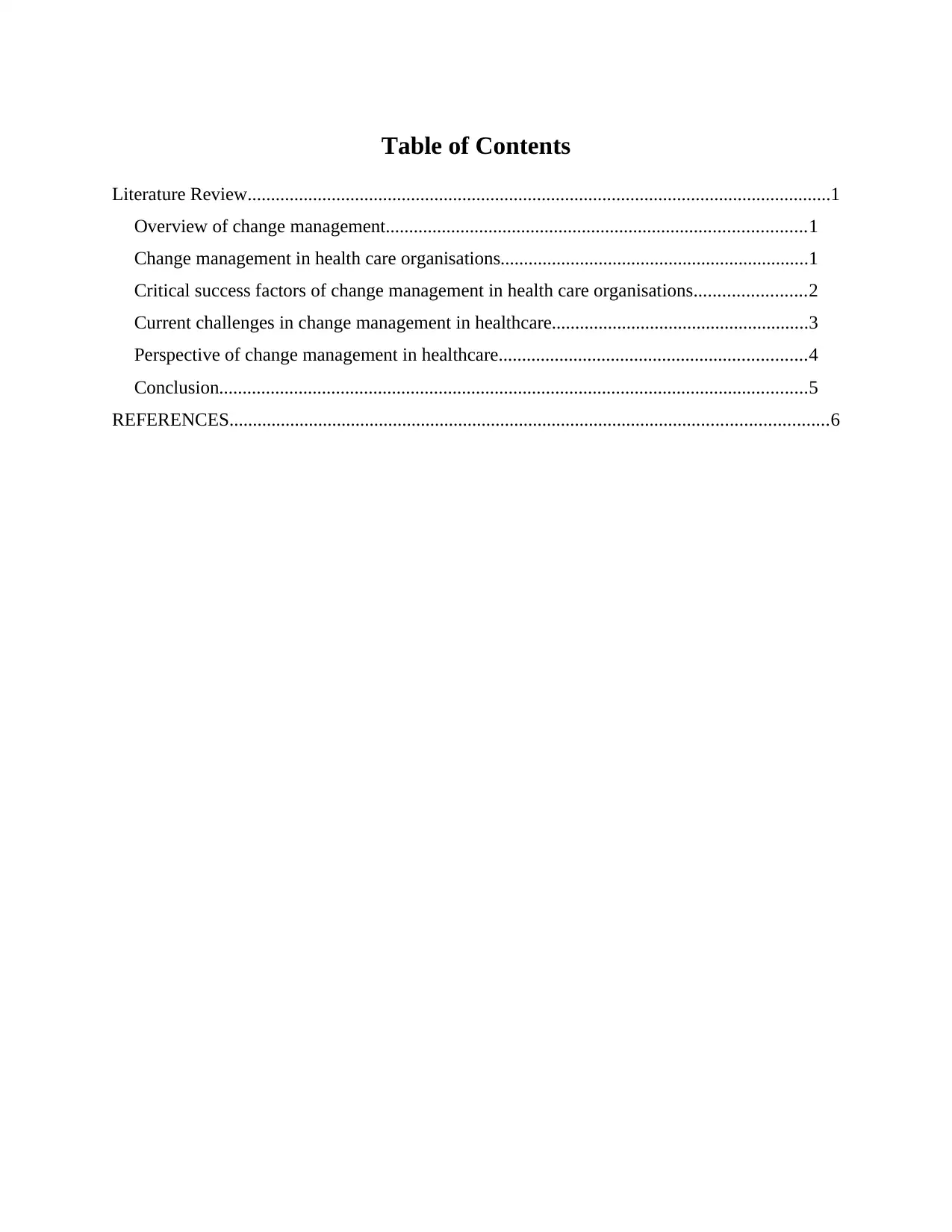
Table of Contents
Literature Review.............................................................................................................................1
Overview of change management..........................................................................................1
Change management in health care organisations..................................................................1
Critical success factors of change management in health care organisations........................2
Current challenges in change management in healthcare.......................................................3
Perspective of change management in healthcare..................................................................4
Conclusion..............................................................................................................................5
REFERENCES................................................................................................................................6
Literature Review.............................................................................................................................1
Overview of change management..........................................................................................1
Change management in health care organisations..................................................................1
Critical success factors of change management in health care organisations........................2
Current challenges in change management in healthcare.......................................................3
Perspective of change management in healthcare..................................................................4
Conclusion..............................................................................................................................5
REFERENCES................................................................................................................................6
⊘ This is a preview!⊘
Do you want full access?
Subscribe today to unlock all pages.

Trusted by 1+ million students worldwide

Literature Review
Overview of change management
The National Health Service (NHS) at United Kingdom has gone through ample amount
of changes since the growth of information technologies. This not only impacts on the healthcare
professionals but also on the overall healthcare institute simultaneously. According to Mintzberg,
(2017) due to evolution of digital technologies, many healthcare professionals at National Health
Services are providing healthcare advises and treatments through internet or video conferencing.
Technology is dramatically improving access to healthcare services in the United Kingdom. Now
with the help of digital technology and information system, patients and readers can access to
thousands of books and journals relating with healthcare from the electronic database of National
Health Services. Imison, Watson and Edwards, (2016) said that Cerner plays an important and
essential role in brining change in the healthcare facilitates and technologies of National Health
Service (NHS).
As per Cresswell and Sheikh, (2015) dealing with change in a professional organization
can be one of the biggest challenges and opportunities in business. This is especially true in the
world of health care and health IT (HIT) – two of the most change-oriented industries. The
transformation influences the health care professionals greatly and it impacts on healthcare
facilities and techniques simultaneously. In this context Curcin and et.al., (2014 argued that
change in healthcare facilities can lead to growth and development of the organisation and
further aid in improvements in treatments and caring of patients. With rapid rising in
technologies, healthcare organisations aims to increase their efficiency in treatment facilities.
Change management in health care organisations
In current health care organisations, manager occupies an extremely challenging position:
how to maintain a competitive edge in the health care market while leading an organization
through constant change (Imison, Watson and Edwards, 2016). Rapid change is occurring as
health care organizations (HCOs) strive to adopt new technology such as the electronic health
record (EHR), implement quality improvement initiatives, and institute pay-for-performance
plans. According to Mintzberg, (2017) health care sector is different from all other sectors as it
is more organised and systematic. Further, healthcare organisations not involved in trade
activities, instead there purpose is to provide health care facilities to the community. In order to
1
Overview of change management
The National Health Service (NHS) at United Kingdom has gone through ample amount
of changes since the growth of information technologies. This not only impacts on the healthcare
professionals but also on the overall healthcare institute simultaneously. According to Mintzberg,
(2017) due to evolution of digital technologies, many healthcare professionals at National Health
Services are providing healthcare advises and treatments through internet or video conferencing.
Technology is dramatically improving access to healthcare services in the United Kingdom. Now
with the help of digital technology and information system, patients and readers can access to
thousands of books and journals relating with healthcare from the electronic database of National
Health Services. Imison, Watson and Edwards, (2016) said that Cerner plays an important and
essential role in brining change in the healthcare facilitates and technologies of National Health
Service (NHS).
As per Cresswell and Sheikh, (2015) dealing with change in a professional organization
can be one of the biggest challenges and opportunities in business. This is especially true in the
world of health care and health IT (HIT) – two of the most change-oriented industries. The
transformation influences the health care professionals greatly and it impacts on healthcare
facilities and techniques simultaneously. In this context Curcin and et.al., (2014 argued that
change in healthcare facilities can lead to growth and development of the organisation and
further aid in improvements in treatments and caring of patients. With rapid rising in
technologies, healthcare organisations aims to increase their efficiency in treatment facilities.
Change management in health care organisations
In current health care organisations, manager occupies an extremely challenging position:
how to maintain a competitive edge in the health care market while leading an organization
through constant change (Imison, Watson and Edwards, 2016). Rapid change is occurring as
health care organizations (HCOs) strive to adopt new technology such as the electronic health
record (EHR), implement quality improvement initiatives, and institute pay-for-performance
plans. According to Mintzberg, (2017) health care sector is different from all other sectors as it
is more organised and systematic. Further, healthcare organisations not involved in trade
activities, instead there purpose is to provide health care facilities to the community. In order to
1
Paraphrase This Document
Need a fresh take? Get an instant paraphrase of this document with our AI Paraphraser

provide effective and efficient services to the patients effectively, healthcare organisation needs
to transform their technologies rapidly. This also aid in increases the skills and efficiencies of
healthcare professionals. Elton and O'Riordan, (2016) argued that change is important and
necessary. Implementation of new technologies leads to growth and development of the
healthcare organisation. The share system developed by the organisation aid in generating
maximum benefits at different health care trust and institutions. The clinical, technical
transformations provides effective and efficient services to the patients. There are certain
advantages associated with the innovation and technological developments. Such as
improvement in healthcare services, patients satisfaction, morality and motivation (Marjanovic
and et.al., 2017). Reduction in the efforts of healthcare professionals and increasing effectiveness
in treatments.
Critical success factors of change management in health care organisations
Change management in healthcare organisation helps in increasing the skills, knowledge
and competencies of healthcare professionals. It helps in growth and development of the
healthcare organisations effectively and efficiently (Sousa, 2015). In order to provide better
healthcare facilities healthcare organisation needs to improve their technologies, equipment and
healthcare facilities. This will help in better treatments of patient and they can recover effectively
and efficiently. Thus, change management must be implied in the healthcare organisations so
that growth and development of healthcare sectors can be made. Change in healthcare
organisation aid in improvement in the performance of healthcare professionals and also
increases satisfaction of patients (Imison, Castle-Clarke and Edwards, 2016). Further, it will also
eliminate the frequent clashes and conflicts from the organisation and helps the management to
move on the path of success and development.
In this context, Ser, Robertson and Sheikh, (2014) said that digital and electronic health
records helps the doctors and healthcare professionals of National Health Services to create and
maintain electronic health records of patient effectively and efficiently. This not only aid in
growth and development of the organisation but also leads to promulgate the performance of
healthcare professionals effectively. According to Cresswell and et.al., (2013) patient treatment
and care has been improved tremendously after the implications of digital technology provided
by Cerner at National Health Services (NHS). Further, the government of United Kingdom
appreciated the implications of digital technologies in health care organisations. Mintzberg,
2
to transform their technologies rapidly. This also aid in increases the skills and efficiencies of
healthcare professionals. Elton and O'Riordan, (2016) argued that change is important and
necessary. Implementation of new technologies leads to growth and development of the
healthcare organisation. The share system developed by the organisation aid in generating
maximum benefits at different health care trust and institutions. The clinical, technical
transformations provides effective and efficient services to the patients. There are certain
advantages associated with the innovation and technological developments. Such as
improvement in healthcare services, patients satisfaction, morality and motivation (Marjanovic
and et.al., 2017). Reduction in the efforts of healthcare professionals and increasing effectiveness
in treatments.
Critical success factors of change management in health care organisations
Change management in healthcare organisation helps in increasing the skills, knowledge
and competencies of healthcare professionals. It helps in growth and development of the
healthcare organisations effectively and efficiently (Sousa, 2015). In order to provide better
healthcare facilities healthcare organisation needs to improve their technologies, equipment and
healthcare facilities. This will help in better treatments of patient and they can recover effectively
and efficiently. Thus, change management must be implied in the healthcare organisations so
that growth and development of healthcare sectors can be made. Change in healthcare
organisation aid in improvement in the performance of healthcare professionals and also
increases satisfaction of patients (Imison, Castle-Clarke and Edwards, 2016). Further, it will also
eliminate the frequent clashes and conflicts from the organisation and helps the management to
move on the path of success and development.
In this context, Ser, Robertson and Sheikh, (2014) said that digital and electronic health
records helps the doctors and healthcare professionals of National Health Services to create and
maintain electronic health records of patient effectively and efficiently. This not only aid in
growth and development of the organisation but also leads to promulgate the performance of
healthcare professionals effectively. According to Cresswell and et.al., (2013) patient treatment
and care has been improved tremendously after the implications of digital technology provided
by Cerner at National Health Services (NHS). Further, the government of United Kingdom
appreciated the implications of digital technologies in health care organisations. Mintzberg,
2
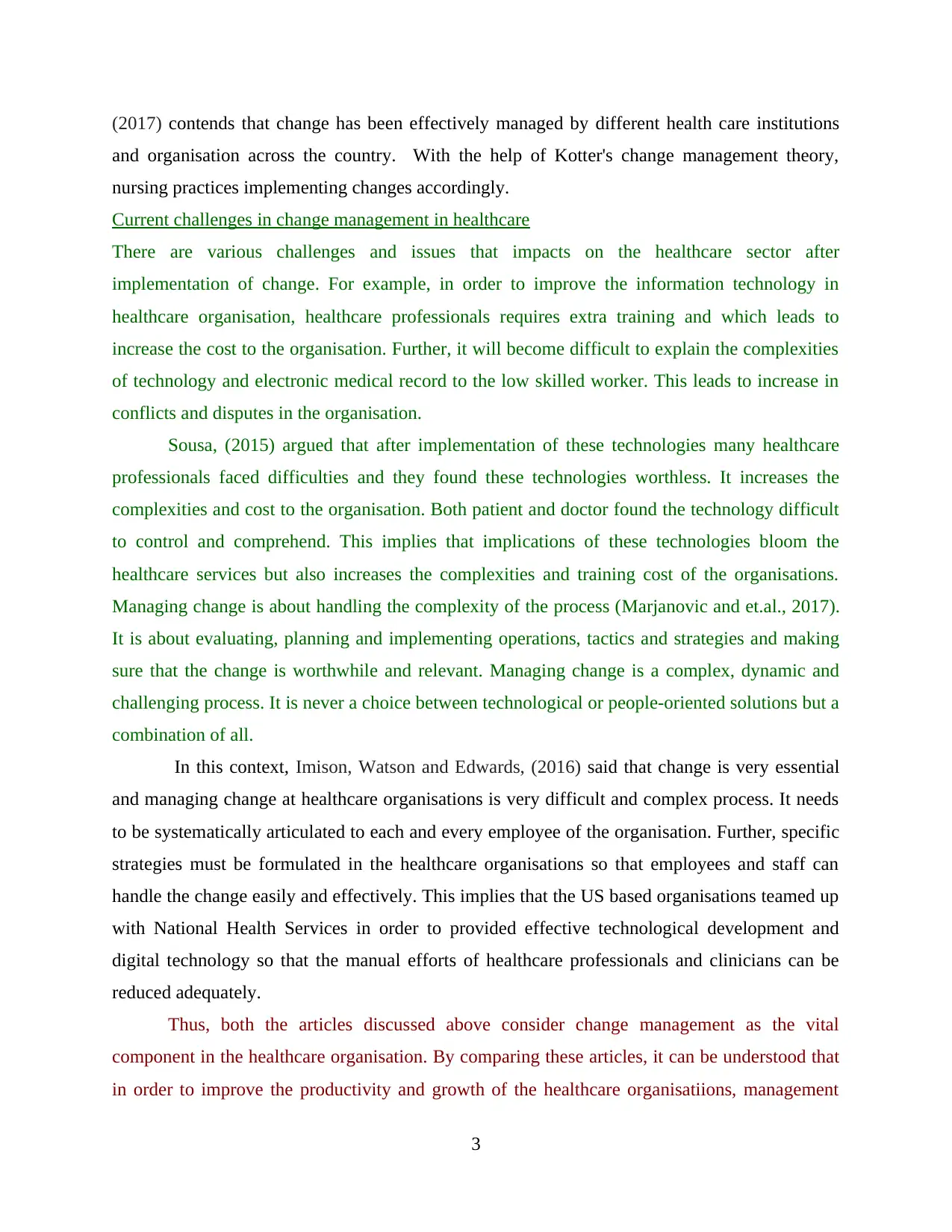
(2017) contends that change has been effectively managed by different health care institutions
and organisation across the country. With the help of Kotter's change management theory,
nursing practices implementing changes accordingly.
Current challenges in change management in healthcare
There are various challenges and issues that impacts on the healthcare sector after
implementation of change. For example, in order to improve the information technology in
healthcare organisation, healthcare professionals requires extra training and which leads to
increase the cost to the organisation. Further, it will become difficult to explain the complexities
of technology and electronic medical record to the low skilled worker. This leads to increase in
conflicts and disputes in the organisation.
Sousa, (2015) argued that after implementation of these technologies many healthcare
professionals faced difficulties and they found these technologies worthless. It increases the
complexities and cost to the organisation. Both patient and doctor found the technology difficult
to control and comprehend. This implies that implications of these technologies bloom the
healthcare services but also increases the complexities and training cost of the organisations.
Managing change is about handling the complexity of the process (Marjanovic and et.al., 2017).
It is about evaluating, planning and implementing operations, tactics and strategies and making
sure that the change is worthwhile and relevant. Managing change is a complex, dynamic and
challenging process. It is never a choice between technological or people-oriented solutions but a
combination of all.
In this context, Imison, Watson and Edwards, (2016) said that change is very essential
and managing change at healthcare organisations is very difficult and complex process. It needs
to be systematically articulated to each and every employee of the organisation. Further, specific
strategies must be formulated in the healthcare organisations so that employees and staff can
handle the change easily and effectively. This implies that the US based organisations teamed up
with National Health Services in order to provided effective technological development and
digital technology so that the manual efforts of healthcare professionals and clinicians can be
reduced adequately.
Thus, both the articles discussed above consider change management as the vital
component in the healthcare organisation. By comparing these articles, it can be understood that
in order to improve the productivity and growth of the healthcare organisatiions, management
3
and organisation across the country. With the help of Kotter's change management theory,
nursing practices implementing changes accordingly.
Current challenges in change management in healthcare
There are various challenges and issues that impacts on the healthcare sector after
implementation of change. For example, in order to improve the information technology in
healthcare organisation, healthcare professionals requires extra training and which leads to
increase the cost to the organisation. Further, it will become difficult to explain the complexities
of technology and electronic medical record to the low skilled worker. This leads to increase in
conflicts and disputes in the organisation.
Sousa, (2015) argued that after implementation of these technologies many healthcare
professionals faced difficulties and they found these technologies worthless. It increases the
complexities and cost to the organisation. Both patient and doctor found the technology difficult
to control and comprehend. This implies that implications of these technologies bloom the
healthcare services but also increases the complexities and training cost of the organisations.
Managing change is about handling the complexity of the process (Marjanovic and et.al., 2017).
It is about evaluating, planning and implementing operations, tactics and strategies and making
sure that the change is worthwhile and relevant. Managing change is a complex, dynamic and
challenging process. It is never a choice between technological or people-oriented solutions but a
combination of all.
In this context, Imison, Watson and Edwards, (2016) said that change is very essential
and managing change at healthcare organisations is very difficult and complex process. It needs
to be systematically articulated to each and every employee of the organisation. Further, specific
strategies must be formulated in the healthcare organisations so that employees and staff can
handle the change easily and effectively. This implies that the US based organisations teamed up
with National Health Services in order to provided effective technological development and
digital technology so that the manual efforts of healthcare professionals and clinicians can be
reduced adequately.
Thus, both the articles discussed above consider change management as the vital
component in the healthcare organisation. By comparing these articles, it can be understood that
in order to improve the productivity and growth of the healthcare organisatiions, management
3
⊘ This is a preview!⊘
Do you want full access?
Subscribe today to unlock all pages.

Trusted by 1+ million students worldwide
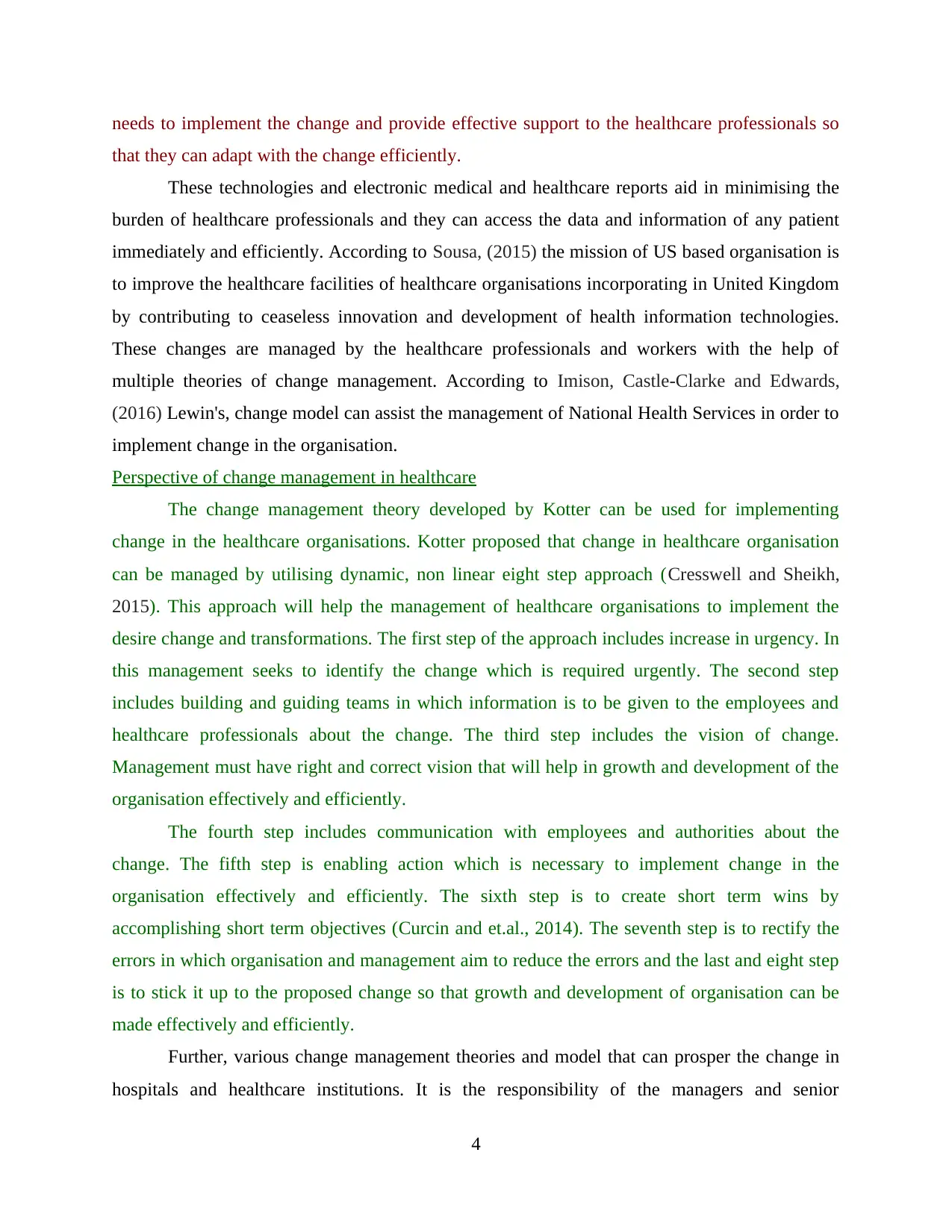
needs to implement the change and provide effective support to the healthcare professionals so
that they can adapt with the change efficiently.
These technologies and electronic medical and healthcare reports aid in minimising the
burden of healthcare professionals and they can access the data and information of any patient
immediately and efficiently. According to Sousa, (2015) the mission of US based organisation is
to improve the healthcare facilities of healthcare organisations incorporating in United Kingdom
by contributing to ceaseless innovation and development of health information technologies.
These changes are managed by the healthcare professionals and workers with the help of
multiple theories of change management. According to Imison, Castle-Clarke and Edwards,
(2016) Lewin's, change model can assist the management of National Health Services in order to
implement change in the organisation.
Perspective of change management in healthcare
The change management theory developed by Kotter can be used for implementing
change in the healthcare organisations. Kotter proposed that change in healthcare organisation
can be managed by utilising dynamic, non linear eight step approach (Cresswell and Sheikh,
2015). This approach will help the management of healthcare organisations to implement the
desire change and transformations. The first step of the approach includes increase in urgency. In
this management seeks to identify the change which is required urgently. The second step
includes building and guiding teams in which information is to be given to the employees and
healthcare professionals about the change. The third step includes the vision of change.
Management must have right and correct vision that will help in growth and development of the
organisation effectively and efficiently.
The fourth step includes communication with employees and authorities about the
change. The fifth step is enabling action which is necessary to implement change in the
organisation effectively and efficiently. The sixth step is to create short term wins by
accomplishing short term objectives (Curcin and et.al., 2014). The seventh step is to rectify the
errors in which organisation and management aim to reduce the errors and the last and eight step
is to stick it up to the proposed change so that growth and development of organisation can be
made effectively and efficiently.
Further, various change management theories and model that can prosper the change in
hospitals and healthcare institutions. It is the responsibility of the managers and senior
4
that they can adapt with the change efficiently.
These technologies and electronic medical and healthcare reports aid in minimising the
burden of healthcare professionals and they can access the data and information of any patient
immediately and efficiently. According to Sousa, (2015) the mission of US based organisation is
to improve the healthcare facilities of healthcare organisations incorporating in United Kingdom
by contributing to ceaseless innovation and development of health information technologies.
These changes are managed by the healthcare professionals and workers with the help of
multiple theories of change management. According to Imison, Castle-Clarke and Edwards,
(2016) Lewin's, change model can assist the management of National Health Services in order to
implement change in the organisation.
Perspective of change management in healthcare
The change management theory developed by Kotter can be used for implementing
change in the healthcare organisations. Kotter proposed that change in healthcare organisation
can be managed by utilising dynamic, non linear eight step approach (Cresswell and Sheikh,
2015). This approach will help the management of healthcare organisations to implement the
desire change and transformations. The first step of the approach includes increase in urgency. In
this management seeks to identify the change which is required urgently. The second step
includes building and guiding teams in which information is to be given to the employees and
healthcare professionals about the change. The third step includes the vision of change.
Management must have right and correct vision that will help in growth and development of the
organisation effectively and efficiently.
The fourth step includes communication with employees and authorities about the
change. The fifth step is enabling action which is necessary to implement change in the
organisation effectively and efficiently. The sixth step is to create short term wins by
accomplishing short term objectives (Curcin and et.al., 2014). The seventh step is to rectify the
errors in which organisation and management aim to reduce the errors and the last and eight step
is to stick it up to the proposed change so that growth and development of organisation can be
made effectively and efficiently.
Further, various change management theories and model that can prosper the change in
hospitals and healthcare institutions. It is the responsibility of the managers and senior
4
Paraphrase This Document
Need a fresh take? Get an instant paraphrase of this document with our AI Paraphraser
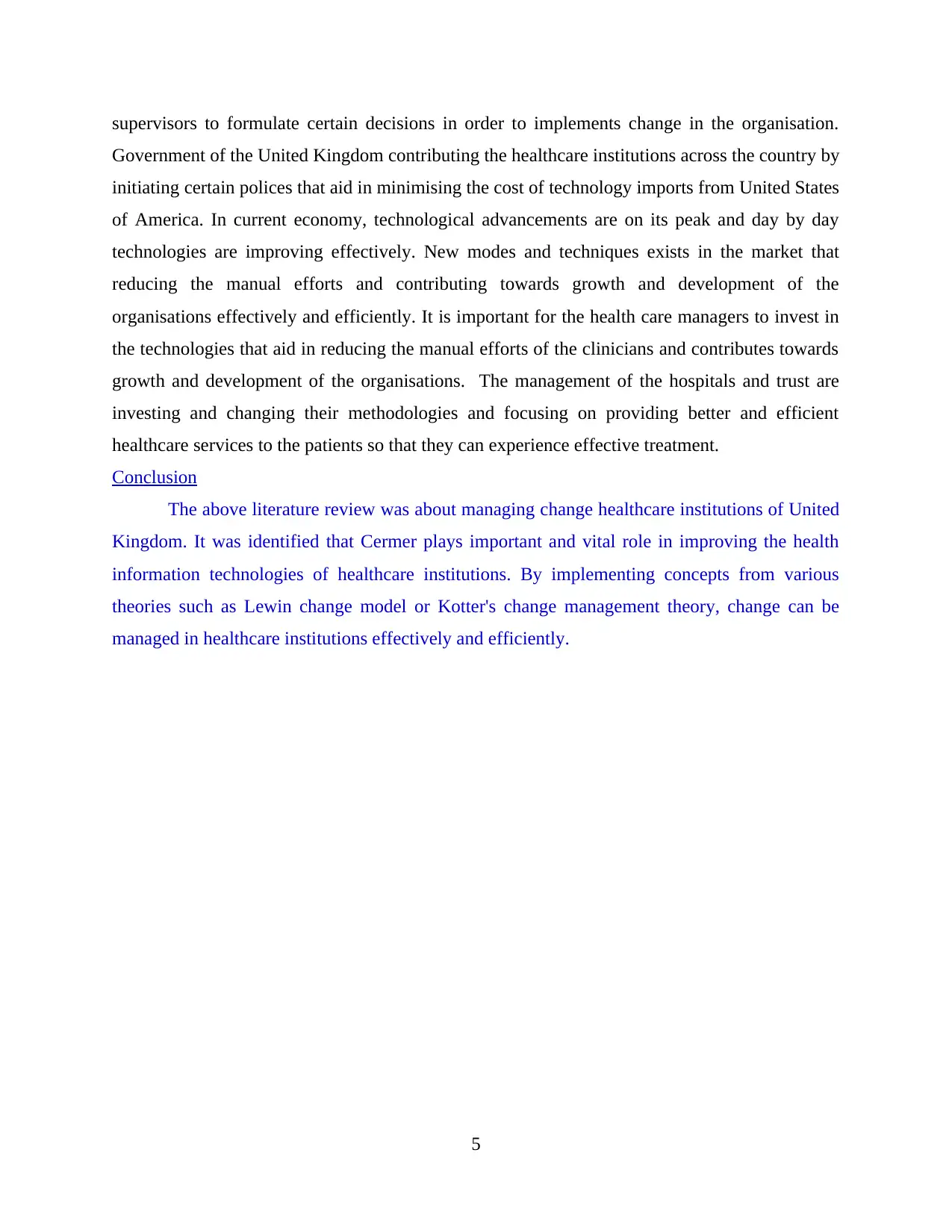
supervisors to formulate certain decisions in order to implements change in the organisation.
Government of the United Kingdom contributing the healthcare institutions across the country by
initiating certain polices that aid in minimising the cost of technology imports from United States
of America. In current economy, technological advancements are on its peak and day by day
technologies are improving effectively. New modes and techniques exists in the market that
reducing the manual efforts and contributing towards growth and development of the
organisations effectively and efficiently. It is important for the health care managers to invest in
the technologies that aid in reducing the manual efforts of the clinicians and contributes towards
growth and development of the organisations. The management of the hospitals and trust are
investing and changing their methodologies and focusing on providing better and efficient
healthcare services to the patients so that they can experience effective treatment.
Conclusion
The above literature review was about managing change healthcare institutions of United
Kingdom. It was identified that Cermer plays important and vital role in improving the health
information technologies of healthcare institutions. By implementing concepts from various
theories such as Lewin change model or Kotter's change management theory, change can be
managed in healthcare institutions effectively and efficiently.
5
Government of the United Kingdom contributing the healthcare institutions across the country by
initiating certain polices that aid in minimising the cost of technology imports from United States
of America. In current economy, technological advancements are on its peak and day by day
technologies are improving effectively. New modes and techniques exists in the market that
reducing the manual efforts and contributing towards growth and development of the
organisations effectively and efficiently. It is important for the health care managers to invest in
the technologies that aid in reducing the manual efforts of the clinicians and contributes towards
growth and development of the organisations. The management of the hospitals and trust are
investing and changing their methodologies and focusing on providing better and efficient
healthcare services to the patients so that they can experience effective treatment.
Conclusion
The above literature review was about managing change healthcare institutions of United
Kingdom. It was identified that Cermer plays important and vital role in improving the health
information technologies of healthcare institutions. By implementing concepts from various
theories such as Lewin change model or Kotter's change management theory, change can be
managed in healthcare institutions effectively and efficiently.
5
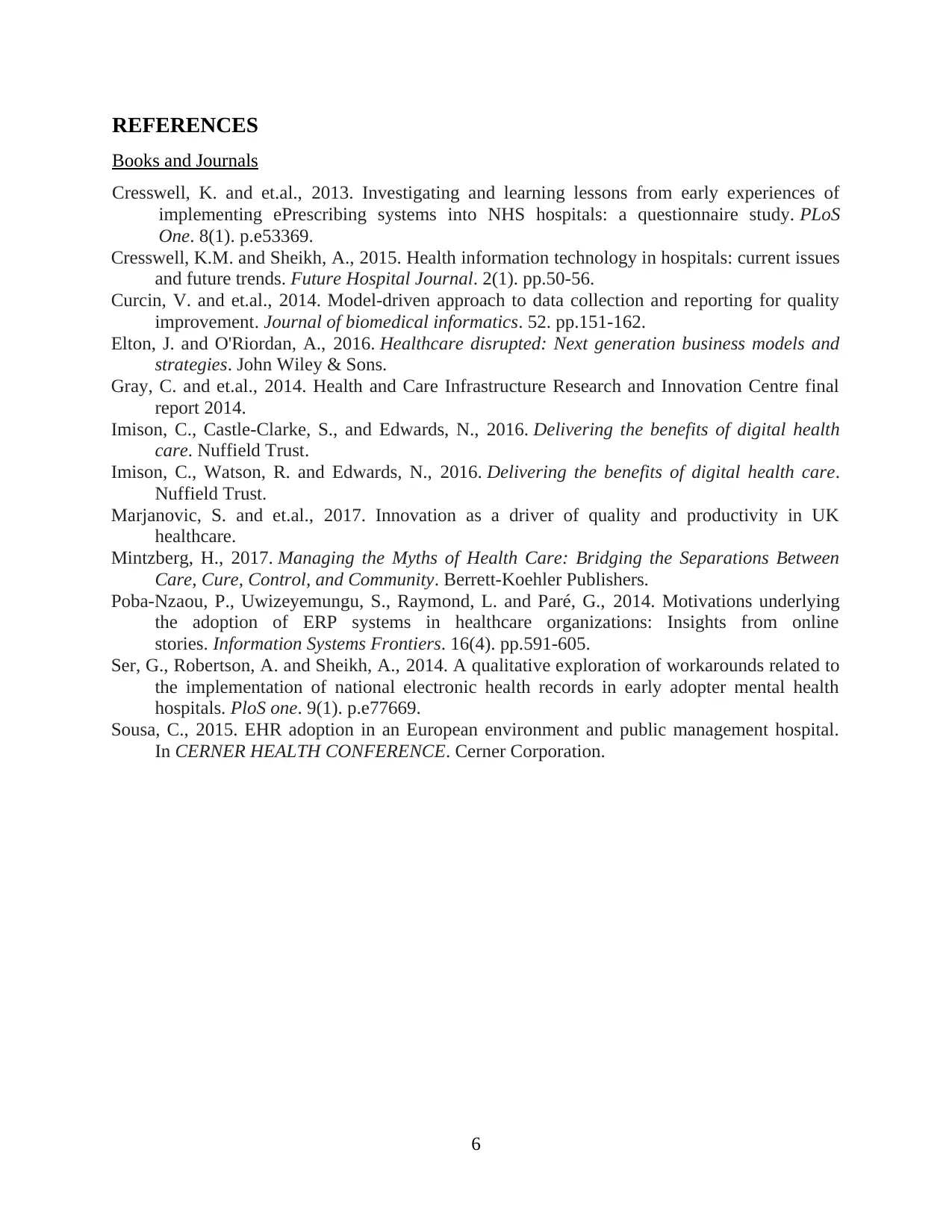
REFERENCES
Books and Journals
Cresswell, K. and et.al., 2013. Investigating and learning lessons from early experiences of
implementing ePrescribing systems into NHS hospitals: a questionnaire study. PLoS
One. 8(1). p.e53369.
Cresswell, K.M. and Sheikh, A., 2015. Health information technology in hospitals: current issues
and future trends. Future Hospital Journal. 2(1). pp.50-56.
Curcin, V. and et.al., 2014. Model-driven approach to data collection and reporting for quality
improvement. Journal of biomedical informatics. 52. pp.151-162.
Elton, J. and O'Riordan, A., 2016. Healthcare disrupted: Next generation business models and
strategies. John Wiley & Sons.
Gray, C. and et.al., 2014. Health and Care Infrastructure Research and Innovation Centre final
report 2014.
Imison, C., Castle-Clarke, S., and Edwards, N., 2016. Delivering the benefits of digital health
care. Nuffield Trust.
Imison, C., Watson, R. and Edwards, N., 2016. Delivering the benefits of digital health care.
Nuffield Trust.
Marjanovic, S. and et.al., 2017. Innovation as a driver of quality and productivity in UK
healthcare.
Mintzberg, H., 2017. Managing the Myths of Health Care: Bridging the Separations Between
Care, Cure, Control, and Community. Berrett-Koehler Publishers.
Poba-Nzaou, P., Uwizeyemungu, S., Raymond, L. and Paré, G., 2014. Motivations underlying
the adoption of ERP systems in healthcare organizations: Insights from online
stories. Information Systems Frontiers. 16(4). pp.591-605.
Ser, G., Robertson, A. and Sheikh, A., 2014. A qualitative exploration of workarounds related to
the implementation of national electronic health records in early adopter mental health
hospitals. PloS one. 9(1). p.e77669.
Sousa, C., 2015. EHR adoption in an European environment and public management hospital.
In CERNER HEALTH CONFERENCE. Cerner Corporation.
6
Books and Journals
Cresswell, K. and et.al., 2013. Investigating and learning lessons from early experiences of
implementing ePrescribing systems into NHS hospitals: a questionnaire study. PLoS
One. 8(1). p.e53369.
Cresswell, K.M. and Sheikh, A., 2015. Health information technology in hospitals: current issues
and future trends. Future Hospital Journal. 2(1). pp.50-56.
Curcin, V. and et.al., 2014. Model-driven approach to data collection and reporting for quality
improvement. Journal of biomedical informatics. 52. pp.151-162.
Elton, J. and O'Riordan, A., 2016. Healthcare disrupted: Next generation business models and
strategies. John Wiley & Sons.
Gray, C. and et.al., 2014. Health and Care Infrastructure Research and Innovation Centre final
report 2014.
Imison, C., Castle-Clarke, S., and Edwards, N., 2016. Delivering the benefits of digital health
care. Nuffield Trust.
Imison, C., Watson, R. and Edwards, N., 2016. Delivering the benefits of digital health care.
Nuffield Trust.
Marjanovic, S. and et.al., 2017. Innovation as a driver of quality and productivity in UK
healthcare.
Mintzberg, H., 2017. Managing the Myths of Health Care: Bridging the Separations Between
Care, Cure, Control, and Community. Berrett-Koehler Publishers.
Poba-Nzaou, P., Uwizeyemungu, S., Raymond, L. and Paré, G., 2014. Motivations underlying
the adoption of ERP systems in healthcare organizations: Insights from online
stories. Information Systems Frontiers. 16(4). pp.591-605.
Ser, G., Robertson, A. and Sheikh, A., 2014. A qualitative exploration of workarounds related to
the implementation of national electronic health records in early adopter mental health
hospitals. PloS one. 9(1). p.e77669.
Sousa, C., 2015. EHR adoption in an European environment and public management hospital.
In CERNER HEALTH CONFERENCE. Cerner Corporation.
6
⊘ This is a preview!⊘
Do you want full access?
Subscribe today to unlock all pages.

Trusted by 1+ million students worldwide
1 out of 9
Related Documents
Your All-in-One AI-Powered Toolkit for Academic Success.
+13062052269
info@desklib.com
Available 24*7 on WhatsApp / Email
![[object Object]](/_next/static/media/star-bottom.7253800d.svg)
Unlock your academic potential
Copyright © 2020–2025 A2Z Services. All Rights Reserved. Developed and managed by ZUCOL.





